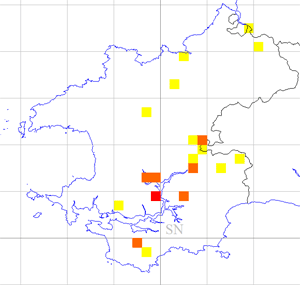Lesser-spotted Woodpecker - 2003-07
 Thursday, May 10, 2012 at 8:57PM
Thursday, May 10, 2012 at 8:57PM Despite their apparent scarcity, with usually only a handful of records received in any one year, the number of tetrads in which they were found was remarkably similar between the two atlas periods, 1984-88 and 2003-07. Whilst breeding was only confirmed in one tetrad, it is acknowledged that Lesser Spotted Woodpeckers are difficult to prove breeding and this decline was more or less balanced by the number of tetrads that registered probable and possible breeding evidence.
In the earlier atlas period, they were patchily distributed, with concentrations along the Western Cleddau river valley from around Millin Pill northwards. They were also reasonably well represented in tetrads further north, generally around the Teifi valley area, while another small concentration occurred in the south-east.
During the recent atlas period there was no evidence of breeding in the Teifi valley, although birds were present and no records at all from the south-east. They were recorded in the Western Cleddau but most records came from the Eastern Cleddau catchment. Whether this is due to a genuine contraction in range is not clear. Because this is a relatively difficult species to find, recorder bias cannot be ruled out. During 1984-88 there were no breeding records south of Milford Haven but breeding occurred between the two atlas periods at Orielton in 1995 (nest with young). In the 2003-07 period breeding may have occurred at Orielton again but was not confirmed.
Donovan and Rees (1994) suggested that Lesser Spotted Woodpeckers had been under-recorded and did not make an estimate of the Pembrokeshire population based on 1984-88 records. Assuming that the number of tetrads in which they were found reasonably represents the breeding population, this may be not less than 19 – 20 pairs in both atlas periods, suggesting population stability.
River-bank tree management may be an issue for this species, but conversely they may also be prospering from river corridor management, where bank-side woody vegetation has been fenced from grazing along lengths of river as part of riparian habitat management schemes. More survey effort is needed to determine breeding density in sample riverine habitat, as well as the relative status of the Western and Eastern Cleddau river valleys, apparently their core breeding areas.
Bob Haycock

Fieldwork 2003-07 (based on 490 tetrads)
Red = breeding confirmed = 1
Orange = breeding probable = 6
Yellow = breeding possible = 12
Total tetrads in which registered = 19 (3.9%)


Reader Comments